-
Countries
-
Data and Analysis
-
Special Focus
-
Crisis Responses
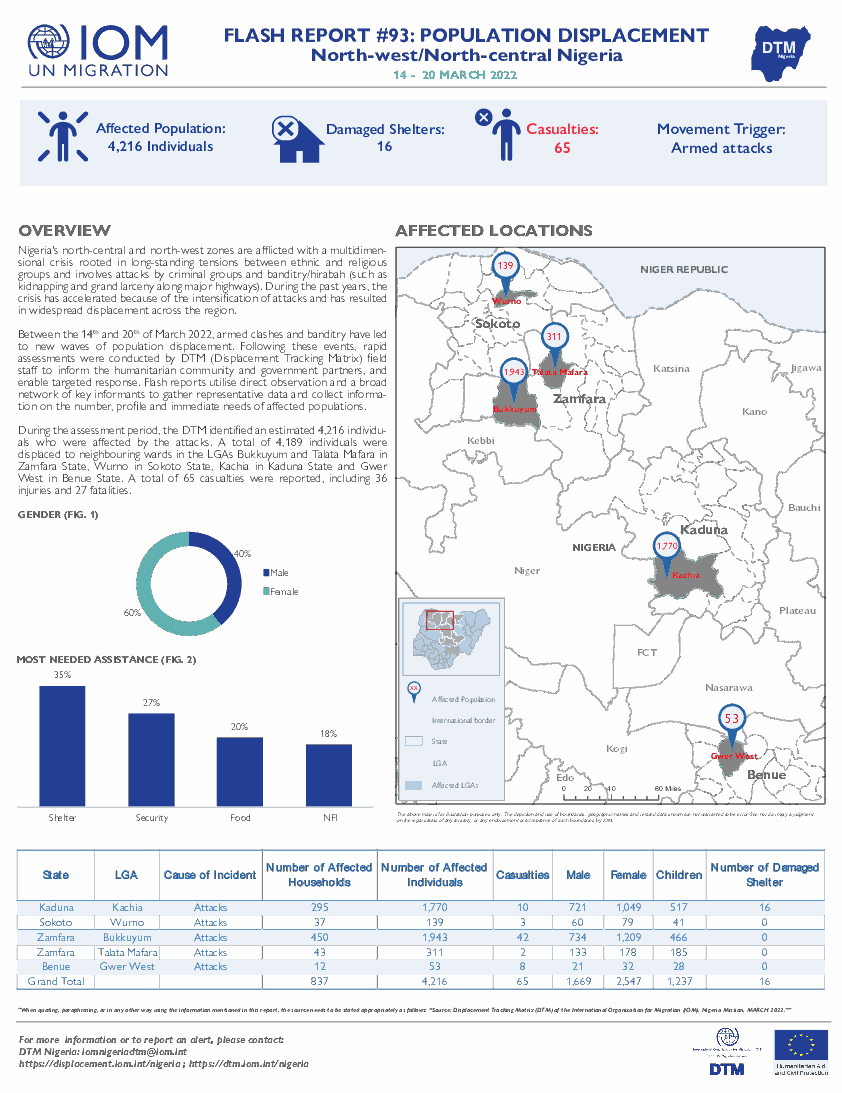
Contact
DTM Nigeria, AllUsersInDTMNigeria@iom.int
Language
English
Location
Nigeria
Period Covered
Mar 14 2022
Mar 20 2022
Activity
- Event Tracking
- Mobility Tracking
Nigeria's north-central and north-west zones are afflicted with a multidimensional crisis rooted in long-standing tensions between ethnic and religious groups and involves attacks by criminal groups and banditry/hirabah (such as kidnapping and grand larceny along major highways). During the past years, the crisis has accelerated because of the intensification of attacks and has resulted in widespread displacement across the region.
Between the 14th and 20th of March 2022, armed clashes and banditry have led to new waves of population displacement. Following these events, rapid assessments were conducted by DTM (Displacement Tracking Matrix) field staff to inform the humanitarian community and government partners, and enable targeted response. Flash reports utilise direct observation and a broad network of key informants to gather representative data and collect information on the number, profile and immediate needs of affected populations.
During the assessment period, the DTM identified an estimated 4,216 individuals who were affected by the attacks. A total of 4,189 individuals were displaced to neighbouring wards in the LGAs Bukkuyum and Talata Mafara in Zamfara State, Wurno in Sokoto State, Kachia in Kaduna State and Gwer West in Benue State. A total of 65 casualties were reported, including 36
injuries and 27 fatalities.
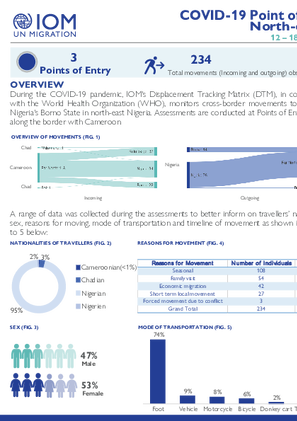
Contact
DTM Nigeria, AllUsersInDTMNigeria@iom.int
Language
English
Location
Nigeria
Period Covered
Mar 12 2022
Mar 18 2022
Activity
- Mobility Tracking
- Baseline Assessment
- Points of Entry (PoE)
During the COVID-19 pandemic, IOM's Displacement Tracking Matrix (DTM), in collaboration with the World Health Organization (WHO), monitors cross-border movements to and from Nigeria's Borno State in north-east Nigeria. Assessments are conducted at Points of Entry located along the border with Cameroon.
A range of data was collected during the assessments to better inform on travellers’ nationalities, sex, reasons for moving, mode of transportation and timeline of movement as shown in figures 2 to 5 below.

Contact
DTM Djibouti, DTMDjibouti@iom.int
Language
French
Location
Djibouti
Period Covered
Feb 01 2022
Feb 28 2022
Activity
- Survey
- Flow Monitoring Survey
- Flow Monitoring
- Migrants presence
Pendant le mois de février 2022, 15 242 mouvements ont été observés aux points de suivi des flux (Flow Monitoring Points, FMP) à Djibouti, soit une moyenne journalière de 544 mouvements. Les flux migratoires ont augmenté de 20 pour cent par rapport au mois de janvier 2022, pendant lequel 454 mouvements avaient été observés en moyenne chaque jour. Cependant, ils n’ont pas encore atteint les niveaux observés pendant la période antérieure à la pandémie de COVID-19 (entre mars 2019 et mars 2020, la moyenne journalière était de 621).

Contact
DTM Djibouti, DTMDjibouti@iom.int
Language
English
Location
Djibouti
Period Covered
Feb 01 2022
Feb 28 2022
Activity
- Survey
- Flow Monitoring Survey
- Flow Monitoring
- Migrants presence
In February 2022, 15,242 movements were observed at the Flow Monitoring Points (FMPs) in Djibouti, representing a daily average of 544 movements. Migration flows increased by 20 per cent compared to the month of January 2022, during which an average of 454 movements had been registered daily. It is worth highlighting that migration flows have not yet reached pre-COVID-19 levels (between March 2019 and March 2020, the daily average was 621).
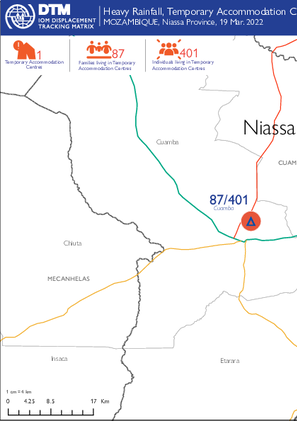
Contact
DTM Support, DTMSupport@iom.int
Language
English
Location
Mozambique
Period Covered
Mar 19 2022
Mar 22 2022
Activity
- Other
IOM MOZAMBIQUE Temporary Accommodation Centre Mapping|Tropical Cyclone Gombe & Heavy Rainfall – Nampula, Zambezia, Niassa and Sofala Provinces, March 2022

Contact
DTMUkraine@iom.int
Language
English
Location
Ukraine
Period Covered
Mar 09 2022
Mar 16 2022
Activity
- Survey
Starting on 24 February 2022, a large scale armed conflict triggered an unprecedented humanitarian crisis across all regions of Ukraine. Between March 9 and 16, the International Organization for Migration (IOM) conducted a rapid representative assessment of the general population in Ukraine to gather initial insights into internal displacement and mobility flows, and to assess local needs. While Displacement Tracking Matrix tools are being established, this general population assessment will serve as a preliminary source to identify areas with high humanitarian needs and to inform the targeting of response aiming to assist the conflict-affected population. The geographical scope of the assessment covers the entire territory of Ukraine, all five macro-regions (West, East, North, Centre, South, and the city of Kyiv), with the exception of the Crimean peninsula. The probabilistic sample, representative at macro-region level, was constructed through a random‐digit‐dial (RDD) approach, and 2,000 respondents aged 18 and over were interviewed using the computer assisted telephone interviewing (CATI) method. Those currently outside Ukraine were not interviewed. Population estimates assume that children travel together with their adult guardians. The estimates rely on the UNFPA population data for Ukraine, agreed upon as the common population baseline by the humanitarian community.
This report is also available in Ukrainian.

Contact
DTM Libya, DTMLibya@iom.int
Language
English
Location
Libya
Period Covered
Mar 13 2022
Mar 19 2022
Activity
- Other
As part of the third phase of the Libyan national COVID-19 vaccination campaign led by the Libyan National Centre for Disease Control (NCDC), IOM conducted awareness raising sessions on COVID-19 vaccines with a total of 604 adult migrants (41 females and 563 males) in three locations, Ain Zara detention centre and community settings in two municipalities during the reporting period (13 - 19 Mar 2022).
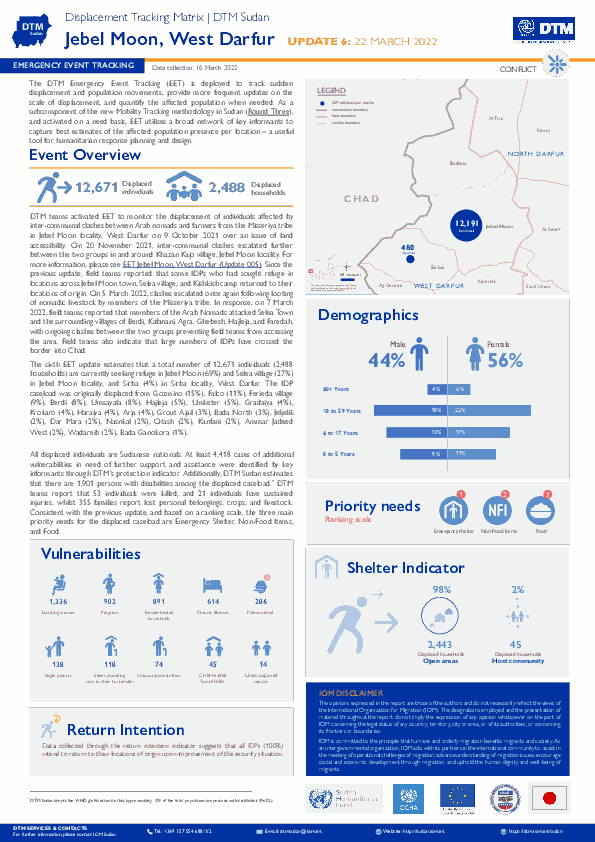
Contact
DTM Sudan; dtmsudan@iom.int
Language
English
Location
Sudan
Snapshot Date
Mar 16 2022
Activity
- Event Tracking
- Mobility Tracking
The DTM Emergency Event Tracking (EET) is deployed to track sudden displacement and population movements, provide more frequent updates on the scale of displacement, and quantify the affected population when needed. As a subcomponent of the new Mobility Tracking methodology in Sudan (Round Three), and activated on a need basis, EET utilises a broad network of key informants to capture best estimates of the affected population presence per location – a useful tool for humanitarian response planning and design.
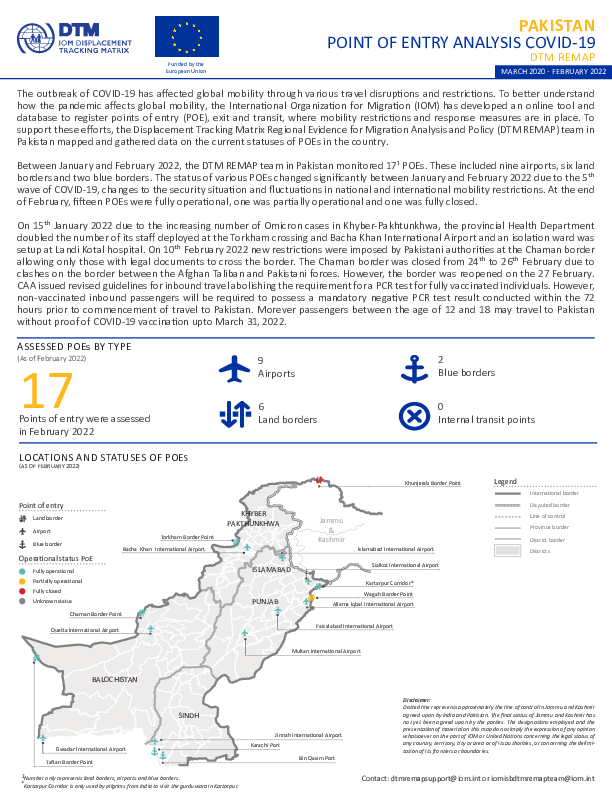
Contact
iomisbdtmremapteam@iom.int
Language
English
Location
Pakistan
Period Covered
Mar 01 2020
Feb 28 2022
Activity
- Points of Entry (PoE)
The outbreak of COVID-19 has affected global mobility through various travel disruptions and restrictions. To better understand how the pandemic affects global mobility, the International Organization for Migration (IOM) has developed an online tool and database to register points of entry (POE), exit and transit, where mobility restrictions and response measures are in place. To support these efforts, the Displacement Tracking Matrix Regional Evidence for Migration Analysis and Policy (DTM REMAP) team in Pakistan mapped and gathered data on the current statuses of POEs in the country.
Between January and February 2022, the DTM REMAP team in Pakistan monitored 17¹ POEs. These included nine airports, six land borders and two blue borders. The status of various POEs changed significantly between January and February 2022 due to the 5th wave of COVID-19, changes to the security situation and fluctuations in national and international mobility restrictions. At the end of February, fifteen POEs were fully operational, one was partially operational and one was fully closed.
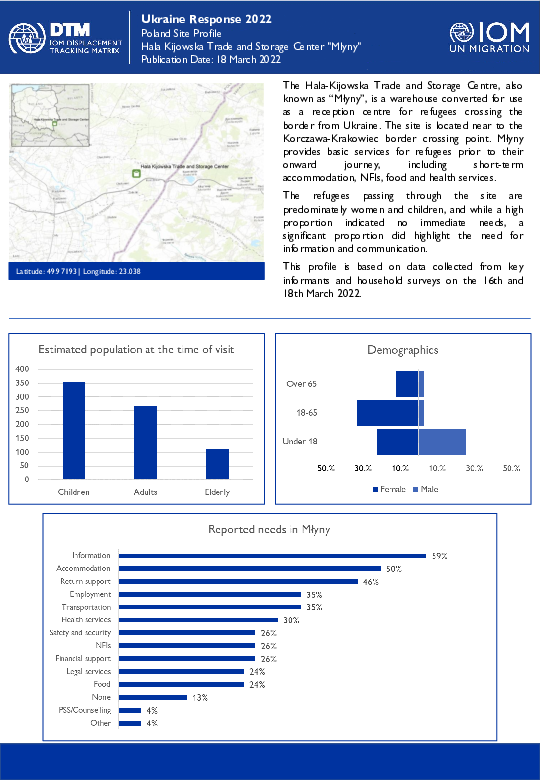
Contact
jslowey@iom.int
Language
English
Location
Poland
Period Covered
Mar 16 2022
Mar 18 2022
Activity
- Survey
The Hala-Kijowska Trade and Storage Centre, also known as “Młyny”, is a warehouse converted for use as a reception centre for refugees crossing the border from Ukraine. The site is located near to the Korczawa-Krakowiec border crossing point. Młyny provides basic services for refugees prior to their onward journey, including short-term accommodation, NFIs, food and health services. The refugees passing through the site are predominately women and children, and while a high proportion indicated no immediate needs, a significant proportion did highlight the need for information and communication. This profile is based on data collected from key informants and household surveys on the 16th and 18th March 2022